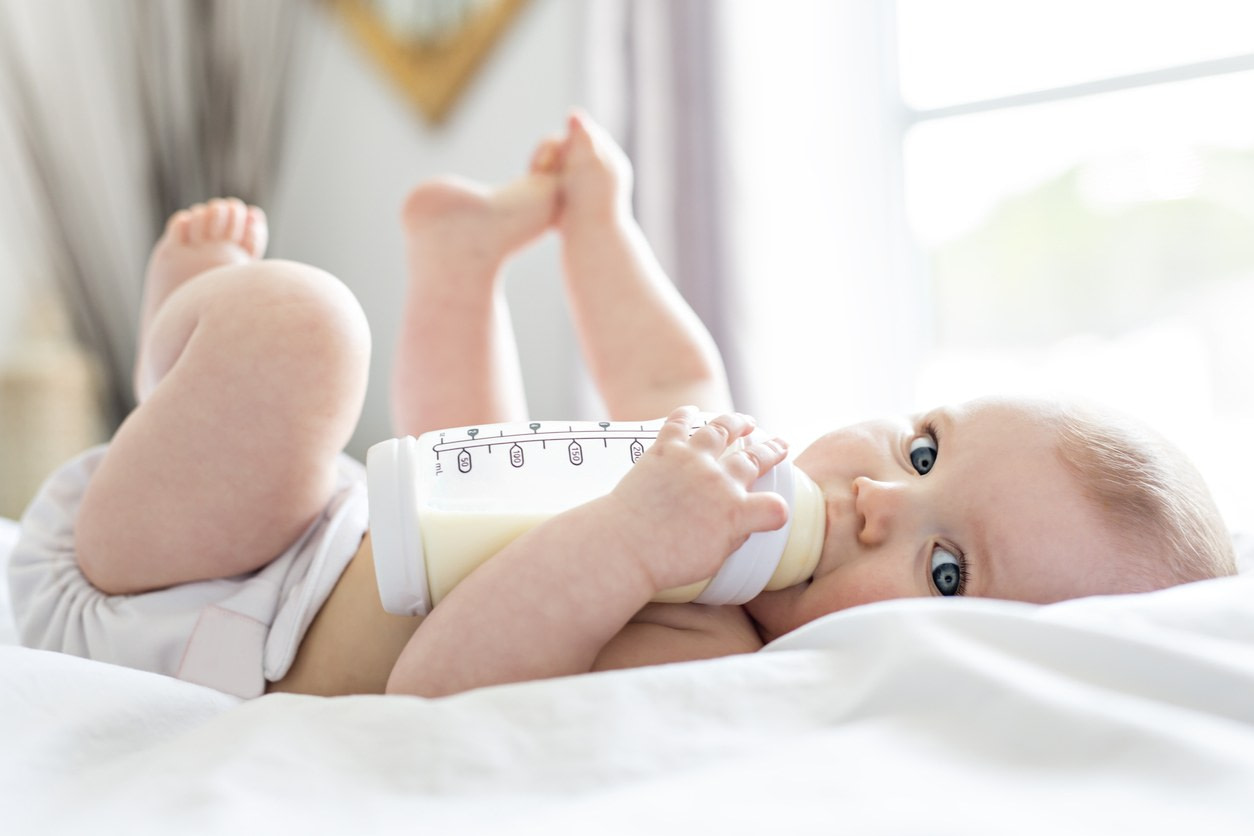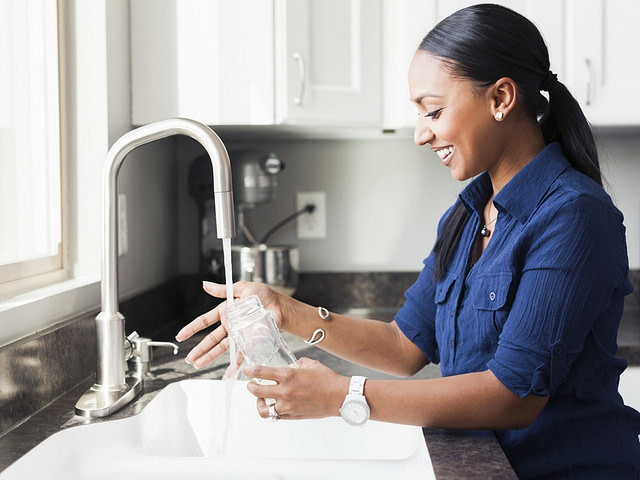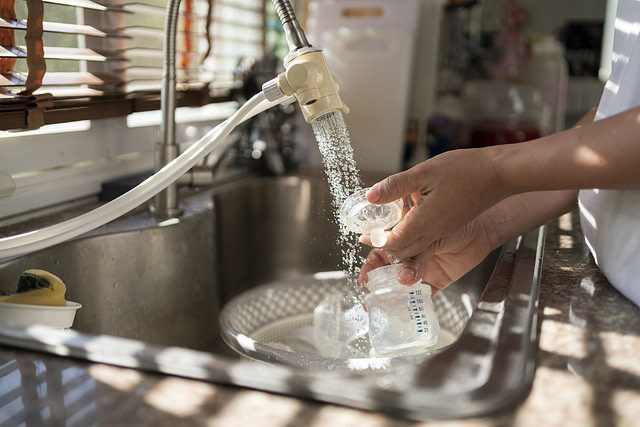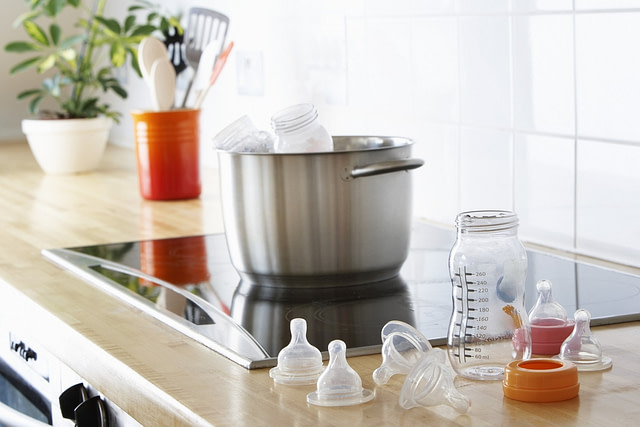How to Clean Baby Bottles
5 minute read

Becoming a parent comes with loads of questions. How long until the baby giggles? When will they say my name? Is it too soon to introduce them to buffalo mac and cheese? Among the many responsibilities on your plate, however, there’s one thing that can confuse first-time parents.
How exactly am I supposed to clean baby bottles?
As your little one grows along with their appetite, so might the mountain of baby bottles in your sink. Knowing how to properly clean baby bottles can be a big relief for any parent.
Cleaning Baby Bottles: Best Practices
Between feeding, naptime, tummy time, feeding again, a video chat with Grandpa, snuggles, and of course another feeding, our baby’s schedule can rival our own busiest days. It’s no wonder they need to eat so often—but the accompanying cleanup can quickly pile up, especially if you’re in the newborn stage.
Like learning how to clean baby toys to help keep your little one germ-free, it’s important to understand how to clean baby bottles, and how often.
How to Hand Wash Baby Bottles
We find that one of the best and most effective ways to clean baby bottles is to hand wash them. If you’re discouraged by how time-consuming that sounds, don’t worry—there are some steps you can take to make things a little easier and more efficient.

Then, follow these steps to clean your baby bottles by hand:
- Gather the right supplies – In addition to your dish soap, we suggest using a sponge or a soft dishcloth to wipe and scrub. A bottle brush can also help you get into every nook and cranny.
- Rinse the bottle – Swish and rinse the bottle under warm water to remove some of the immediate residues
- Fill a clean sink – Use hot water and add in a little bit of our plant-powered dish soap.
- Separate the components – The bottle’s contents can get stuck in the nipple and between the bottle and the ring. To avoid any surprise buildup in hard-to-reach areas, we recommend separating these smaller bottle parts and components and cleaning them individually.
- Wash – Put each part into the soapy water and give them a wash.
- Rinse again – Run a little bit of water and thoroughly rinse each part, so there’s no soapy residue left behind.
- Dry – Now that you’ve thoroughly cleaned your baby bottles, you just need to place the parts on a drying rack.
How to Wash Baby Bottles in a Dishwasher
Sometimes, our baby bottles seem to stack up even faster than our tiny tots grow—in other words, lightning fast. If you’re feeling overwhelmed by your washing duties, the dishwasher can help you save some time.
Stay on top of bottle buildup with these easy steps for dishwasher bottle cleaning:
- Rinse – Before putting them in the dishwasher, rinse the caps, nipples, bottles, and any other components with warm water.
- Soak – After you rinse, soak the components in dish soap and warm water to loosen any grime or buildup.
- Put them into the dishwasher – Make sure you rinse off the components one more time before placing them on the top rack.
- Use a hot water cycle – Hot water is another effective method to help clean off bacteria, and a heated drying cycle is equally important.
- Dry – Take the components out of the dishwasher and place them on a dish drying rack, allowing them to dry off completely.
Our ECOS tip: If you decide to use your dishwasher to clean baby bottles, try to run the cycle with a full load and during off-peak hours to help reduce energy use and costs.

Do You Have to Sanitize Baby Bottles After Every Use?
Knowing how sensitive our little ones can be, it’s easy to let our imaginations run wild with visions of dangerous germs making homes in even freshly washed bottles. As long as you’re washing them after each feeding, you usually don’t need to sanitize baby bottles after every use.
With that said, we recommend that you sanitize bottles before you use them for the first time and continue to wash them after every feeding.
However, it can be important to give the bottles a deep clean every couple of weeks since your little bundle of joy hasn’t fully developed their immune system. There are also few instances where your baby bottles could require more regular sanitization.
For instance, if your baby was born prematurely, is younger than 3 months old, or has a weakened or compromised immune system, then sanitizing is essential to keeping them safe.
Other Reasons to Sanitize Baby Bottles
There are times when sanitizing more frequently can be necessary for health reasons. These include:
- If your baby has been sick – No one wants the sniffles, but what’s even worse is getting them twice in a row. Sanitizing bottles can reduce the possibility of your little one getting re-infected.
- Using secondhand or borrowed bottles – Have you inherited some hand-me-down baby gear from a friend or snagged some gently used bottles from an online marketplace? Bravo on the excellent finds. However, sanitization is critical before using secondhand or borrowed bottles with your baby for the first time.
- If your drinking water isn’t clean – Perhaps your home faucet produces less-than-pristine H2O, or you’re visiting a location where tap water quality seems questionable. If you use that water to clean your bottles, sanitizing them afterward may help to avoid harmful microbes.
How Do You Sanitize Baby Bottles Without Negatively Impacting Your Baby’s (or the Planet’s) Health?
Before you break out the power washer and harsh cleaners, we suggest using a more natural way to sanitize bottles safely.
Whether you’re simply cleaning baby bottles or doing a deep-clean sanitation, going about it in a safer way has loads of benefits—both for your baby and for the planet. While harsh toxins left behind by chemical cleaners can irritate your child’s digestive system, plant-powered cleaners like ECOS use safer ingredients that won’t leave behind any harmful traces.
When you do need to sanitize baby bottles, you can choose between several methods that can ensure you both remove nasty germs and avoid introducing harmful toxins.

Sanitize Bottles With Boiling Water
One of the easiest and safest ways to sanitize baby bottles is to give them a bath in boiling water. Simply follow these instructions:
- Take the baby bottles apart and put each piece in a large, clean pot.
- Fill the pot with enough water to cover each baby bottle component.
- Bring the pot to a boil and then continue to boil them on high for about 5 minutes.
- After the water has cooled, remove the bottle parts and let them dry on a clean surface or dish towel.
Sanitize Bottles in the Microwave
Another easy-peasy way to sanitize baby bottles is in the microwave. Follow these steps for a hassle-free process:
- First, make sure the microwave is clean. You don’t want any food splatters to contaminate the cleaning process.
- Fill each baby bottle with water, around half full.
- Place the baby bottles in the microwave and zap them on high for 1 to 2 minutes.
- The baby bottles and the water in them will be hot when they’re done, so let them sit for a few minutes. Use oven mitts or a dish towel to remove the bottles, then drain the water and let them air dry.
Use an Electric Steam Sanitizer
If you want to take your baby bottle sanitizing to the next level, you can purchase a store-bought electric steam sanitizer made just for that purpose.
Electric sanitizers can be an effective way to easily remove unwanted germs. Simply follow the instructions that come in the box and sanitize every part of the baby bottle. You can often use such machines to sanitize teething rings and plastic toys.
Are Soap and Water Enough to Clean Baby Bottles?
We understand a parent’s desire to keep everything their darling touches squeaky clean. Who wouldn’t want to keep their doodlebug out of harm’s way as much as possible? However, you can safely put down the flamethrower when it comes to cleaning baby bottles. In most cases, soap and water are enough for a standard cleaning.
When it comes to choosing the right soap, however, we suggest looking closely at the ingredients. Some of the dish soaps commonly stocked at supermarkets are packed with harmful chemicals. Be sure to avoid to avoid the following ingredients:
- Synthetic polymers
- Phosphates
- Ethanolamines
- 1,4-Dioxane
- Dyes and other colors
If you’re ever unsure about the products in your cart, look for the Safer Choice logo. This certification indicates cleaning products that are safer for you and the environment, without sacrificing performance
Let ECOS Do the Cleaning for You
There’s a lot to think about when it comes to parenting, from how to clean baby clothes to cleaning their toys—never mind knowing how to properly clean baby bottles. But if the mountain of bottles in your sink has you feeling on edge, take any worry you have and throw it in the diaper bin. Our safer cleaning products and our formula is 100% vegan formulas have you covered.
